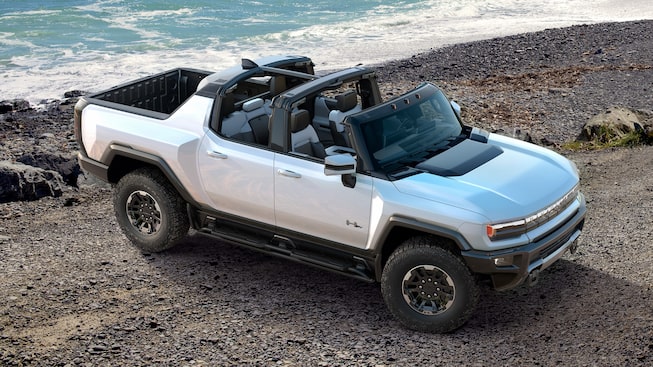Good afternoon, everyone.
I ended up trading Ruby the EV6 for a Model Y last night. My 5 months with the EV6 was fantastic, and the mechanical bits were every bit as awesome as I hoped going in. Ultimately, it was the lousy CCS charging experience combined with software that seemed like an afterthought that drove me to making the switch. For anyone interested, here are a few thoughts I have between the two.
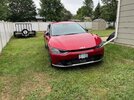
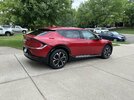
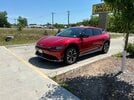
Driving
The driving experience between the two is very different. The aggressive looks of the EV6 belie its fantastic road manners and refinement. I think my EV6 was the quietest and best-riding car I've ever had, and was MUCH better than the Model 3 that I had for two years previously. Everything was tight, there were no unusual noises, and it was a joy on the highway. In comparison, the Y has a choppier ride, a bit more noise, and a strange booming resonance when I go over bumps at higher speed. It's not enough to be intrusive and much better than my '19 Model 3 was, but not to the level of the EV6.
Compared to the athletic EV6, I think the Model Y looks like a bloated fish. But the handling is the polar opposite with the aggressive steering ratio and smaller wheel. Despite its much larger size, the Model Y is 330 lbs lighter, and you can feel it. My AWD EV6 had the slick front axle disconnect that improved high-speed efficiency, but it came at the expense of a noticeable lag as the motor spun up deliver the power that my right foot was requesting. The Y is locked in at all times, and power comes on like a hammer. The standard Y calibration has a throttle tip-in that's somewhere between normal and Sport Mode on the EV6.
For overall performance, they're extremely close. I've seen drag races where the EV6 was right next to the Model Y up to about 60 MPH, and that's about my experience. The RWD EV6 isn't anything special for performance, but my AWD model felt like a rocketship. I think my '19 Standard Range 3 would walk it above 70 MPH though; the power dropoff at higher speeds was more pronounced. Below 60, it wasn't even close. Up until the Model Y, that EV6 was the fastest thing I've owned.
Interior and Storage
The Model Y really stands out for interior usability. It has a much larger cabin with over 75 cubic feet(2.12 cubic meters) compared to 52(1.47 cubic meters) for the EV6. The difference feels smaller because of how well laid out the EV6 is, but you can't beat the massive trunk well and frunk. Today was a good reminder of why I liked that frunk in the wintertime when I loaded almost half of a shopping cart's worth of cold groceries in the frunk to keep them chilled on the hour-long ride home. It's tough to beat that convenience.
The center console of the Y is closed off to deliver a cockpit-like feel, which isn't as usable as the big open tub underneath the rotary shifter in the EV6. The wireless charger is a better compared to the single unit under the driver's arm on the EV6. I never used it on my EV6 because of wired CarPlay, but that's a language that Tesla does not speak, so I'll be using it from now on. My Y came with the optional white interior, which looks great when it's clean. I'm concerned about keeping it that way, as I'm a bit neurotic about having a decent-looking car.
The EV6 is a lot more usable than the size difference would suggest. The overall passenger room seems about even between the two, but the rear passengers sit lower than the Y. The long cargo area is great. The first photo below is my EV6 swallowing 10 bags of topsoil with a rake and hose on top. My boys were comfortably in the back seat for the ride home, and there was no noticeable squatting with the added weight. I was impressed.
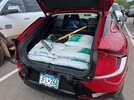
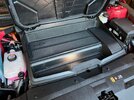
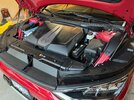
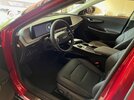
Infotainment/Navigation.
This is the one area that Tesla has the clear advantage. This shouldn't be news to anyone here. The physical controls of the EV6 great, but it didn't take long to get used to Tesla's system again despite the critical reviews. I hate the fact that Tesla does not support CarPlay, but Tesla's in-car system remains the best in the business despite some rearranging since I last left. The second-generation system in my Y with the Ryzen processor is noticeably snappier than the one in my last Tesla. And even the old Intel chip would leave Kia's UVO system in the dust.
I never had a problem with the speed of Kia's system, though, and I always enjoyed how many options we had within the various menus. But my early-build EV6 lacked preconditioning, and it's been made clear that this feature cannot be added within a simple OTA update. The EV6 doesn't have any kind of trip-planning function and doesn't give you a battery estimate of what will remain once you arrive. That's a major oversight for a company that's been making EVs for three years now, but I expect it will eventually be corrected with an OTA update at some point down the line. This shouldn't be a hard problem for Kia to solve.
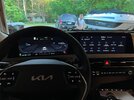
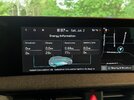
To my ear, Tesla has a clear advantage with their sound system. I sat in the EV6 for the first time with high hopes for the 14-speaker Meridian system, but it was a big disappointment. It sounded better than most unbranded systems that I've had in the past, and better than the one in my Standard Range '19 Model 3, but that's as much as I'd give it. I believe this is a calibration issue more than a speaker quality one, so I hope there's some kind of improvement that gets released in the future. In comparison, the Model Y has deep, powerful bass and clear highs that are somewhat neutered when driven by Bluetooth audio. Seems to be better with direct streaming through Spotify, though. I switched to Apple Music when they came out with lossless a couple of years ago, so I hope to get the holiday update to compare the two soon.
Other stuff.
Tesla has long had the best mobile app in the business, and it's gotten even better since I sold my 3. The Kia app is functionally braindead in comparison. It's capable of remotely starting the HVAC, but you only have a limited degree of control. You can set the climate temp at the start, but you can't change it without stopping the system and adjusting the settings within the app. Once you send the command, you have to wait 5-20 seconds for the signal to be sent to the car and the app confirms the change. If you try and change anything before that, you get an "Error: Command in progress." For some silly reason, you can remotely enable the steering wheel heater with climate, but not the seats? It's really bizarre to slide into a warm cabin, grab a toasty wheel, and have a freezing ass.
Kia advertises their 800v system, and for very good reason. The EV6 is a charging hero, and I don't expect the Model Y will be able to beat it. This thing would hold 220 kW from 10-60%, which made it charge the 77 kWh battery to 80% in about 20 minutes. I did this repeatedly on a road trip over the summer. Of course, this isn't possible in the winter with the lack of preconditioning, but later-build EV6es had that fixed. The Electrify America network is every bit the dumpster fire you've heard about, but when they work, it's fast. This won't last forever, though. I was also impressed with how strong the regen is on the EV6. It's noticeably stronger at all speeds to the Model Y despite the Y weighing 300 lbs less. You can do some neat things with 800v because you don't need as much current to do the same amount of work.
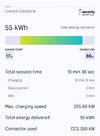
To conclude, my time spent with the EV6 was mostly filled with great thoughts. I really got to love the refinement and outstanding fast-charging capability. My previous experience was with a '19 Tesla Model 3 with a PTC heater that wasn't capable of achieving its 240-mile rated range in sunny weather rolling down a hill. The EV6 never disappointed me for range, and I was impressed with how well it manages energy. I certainly wouldn't rule out another Kia EV in the future, and Tesla needs to step up their game if they expect to retain their longstanding primacy in the EV market. An EV6 with a Tesla-like software experience would have the Model Y pretty well dialed in.

I ended up trading Ruby the EV6 for a Model Y last night. My 5 months with the EV6 was fantastic, and the mechanical bits were every bit as awesome as I hoped going in. Ultimately, it was the lousy CCS charging experience combined with software that seemed like an afterthought that drove me to making the switch. For anyone interested, here are a few thoughts I have between the two.



Driving
The driving experience between the two is very different. The aggressive looks of the EV6 belie its fantastic road manners and refinement. I think my EV6 was the quietest and best-riding car I've ever had, and was MUCH better than the Model 3 that I had for two years previously. Everything was tight, there were no unusual noises, and it was a joy on the highway. In comparison, the Y has a choppier ride, a bit more noise, and a strange booming resonance when I go over bumps at higher speed. It's not enough to be intrusive and much better than my '19 Model 3 was, but not to the level of the EV6.
Compared to the athletic EV6, I think the Model Y looks like a bloated fish. But the handling is the polar opposite with the aggressive steering ratio and smaller wheel. Despite its much larger size, the Model Y is 330 lbs lighter, and you can feel it. My AWD EV6 had the slick front axle disconnect that improved high-speed efficiency, but it came at the expense of a noticeable lag as the motor spun up deliver the power that my right foot was requesting. The Y is locked in at all times, and power comes on like a hammer. The standard Y calibration has a throttle tip-in that's somewhere between normal and Sport Mode on the EV6.
For overall performance, they're extremely close. I've seen drag races where the EV6 was right next to the Model Y up to about 60 MPH, and that's about my experience. The RWD EV6 isn't anything special for performance, but my AWD model felt like a rocketship. I think my '19 Standard Range 3 would walk it above 70 MPH though; the power dropoff at higher speeds was more pronounced. Below 60, it wasn't even close. Up until the Model Y, that EV6 was the fastest thing I've owned.
Interior and Storage
The Model Y really stands out for interior usability. It has a much larger cabin with over 75 cubic feet(2.12 cubic meters) compared to 52(1.47 cubic meters) for the EV6. The difference feels smaller because of how well laid out the EV6 is, but you can't beat the massive trunk well and frunk. Today was a good reminder of why I liked that frunk in the wintertime when I loaded almost half of a shopping cart's worth of cold groceries in the frunk to keep them chilled on the hour-long ride home. It's tough to beat that convenience.
The center console of the Y is closed off to deliver a cockpit-like feel, which isn't as usable as the big open tub underneath the rotary shifter in the EV6. The wireless charger is a better compared to the single unit under the driver's arm on the EV6. I never used it on my EV6 because of wired CarPlay, but that's a language that Tesla does not speak, so I'll be using it from now on. My Y came with the optional white interior, which looks great when it's clean. I'm concerned about keeping it that way, as I'm a bit neurotic about having a decent-looking car.
The EV6 is a lot more usable than the size difference would suggest. The overall passenger room seems about even between the two, but the rear passengers sit lower than the Y. The long cargo area is great. The first photo below is my EV6 swallowing 10 bags of topsoil with a rake and hose on top. My boys were comfortably in the back seat for the ride home, and there was no noticeable squatting with the added weight. I was impressed.




Infotainment/Navigation.
This is the one area that Tesla has the clear advantage. This shouldn't be news to anyone here. The physical controls of the EV6 great, but it didn't take long to get used to Tesla's system again despite the critical reviews. I hate the fact that Tesla does not support CarPlay, but Tesla's in-car system remains the best in the business despite some rearranging since I last left. The second-generation system in my Y with the Ryzen processor is noticeably snappier than the one in my last Tesla. And even the old Intel chip would leave Kia's UVO system in the dust.
I never had a problem with the speed of Kia's system, though, and I always enjoyed how many options we had within the various menus. But my early-build EV6 lacked preconditioning, and it's been made clear that this feature cannot be added within a simple OTA update. The EV6 doesn't have any kind of trip-planning function and doesn't give you a battery estimate of what will remain once you arrive. That's a major oversight for a company that's been making EVs for three years now, but I expect it will eventually be corrected with an OTA update at some point down the line. This shouldn't be a hard problem for Kia to solve.


To my ear, Tesla has a clear advantage with their sound system. I sat in the EV6 for the first time with high hopes for the 14-speaker Meridian system, but it was a big disappointment. It sounded better than most unbranded systems that I've had in the past, and better than the one in my Standard Range '19 Model 3, but that's as much as I'd give it. I believe this is a calibration issue more than a speaker quality one, so I hope there's some kind of improvement that gets released in the future. In comparison, the Model Y has deep, powerful bass and clear highs that are somewhat neutered when driven by Bluetooth audio. Seems to be better with direct streaming through Spotify, though. I switched to Apple Music when they came out with lossless a couple of years ago, so I hope to get the holiday update to compare the two soon.
Other stuff.
Tesla has long had the best mobile app in the business, and it's gotten even better since I sold my 3. The Kia app is functionally braindead in comparison. It's capable of remotely starting the HVAC, but you only have a limited degree of control. You can set the climate temp at the start, but you can't change it without stopping the system and adjusting the settings within the app. Once you send the command, you have to wait 5-20 seconds for the signal to be sent to the car and the app confirms the change. If you try and change anything before that, you get an "Error: Command in progress." For some silly reason, you can remotely enable the steering wheel heater with climate, but not the seats? It's really bizarre to slide into a warm cabin, grab a toasty wheel, and have a freezing ass.
Kia advertises their 800v system, and for very good reason. The EV6 is a charging hero, and I don't expect the Model Y will be able to beat it. This thing would hold 220 kW from 10-60%, which made it charge the 77 kWh battery to 80% in about 20 minutes. I did this repeatedly on a road trip over the summer. Of course, this isn't possible in the winter with the lack of preconditioning, but later-build EV6es had that fixed. The Electrify America network is every bit the dumpster fire you've heard about, but when they work, it's fast. This won't last forever, though. I was also impressed with how strong the regen is on the EV6. It's noticeably stronger at all speeds to the Model Y despite the Y weighing 300 lbs less. You can do some neat things with 800v because you don't need as much current to do the same amount of work.

To conclude, my time spent with the EV6 was mostly filled with great thoughts. I really got to love the refinement and outstanding fast-charging capability. My previous experience was with a '19 Tesla Model 3 with a PTC heater that wasn't capable of achieving its 240-mile rated range in sunny weather rolling down a hill. The EV6 never disappointed me for range, and I was impressed with how well it manages energy. I certainly wouldn't rule out another Kia EV in the future, and Tesla needs to step up their game if they expect to retain their longstanding primacy in the EV market. An EV6 with a Tesla-like software experience would have the Model Y pretty well dialed in.
Last edited:



